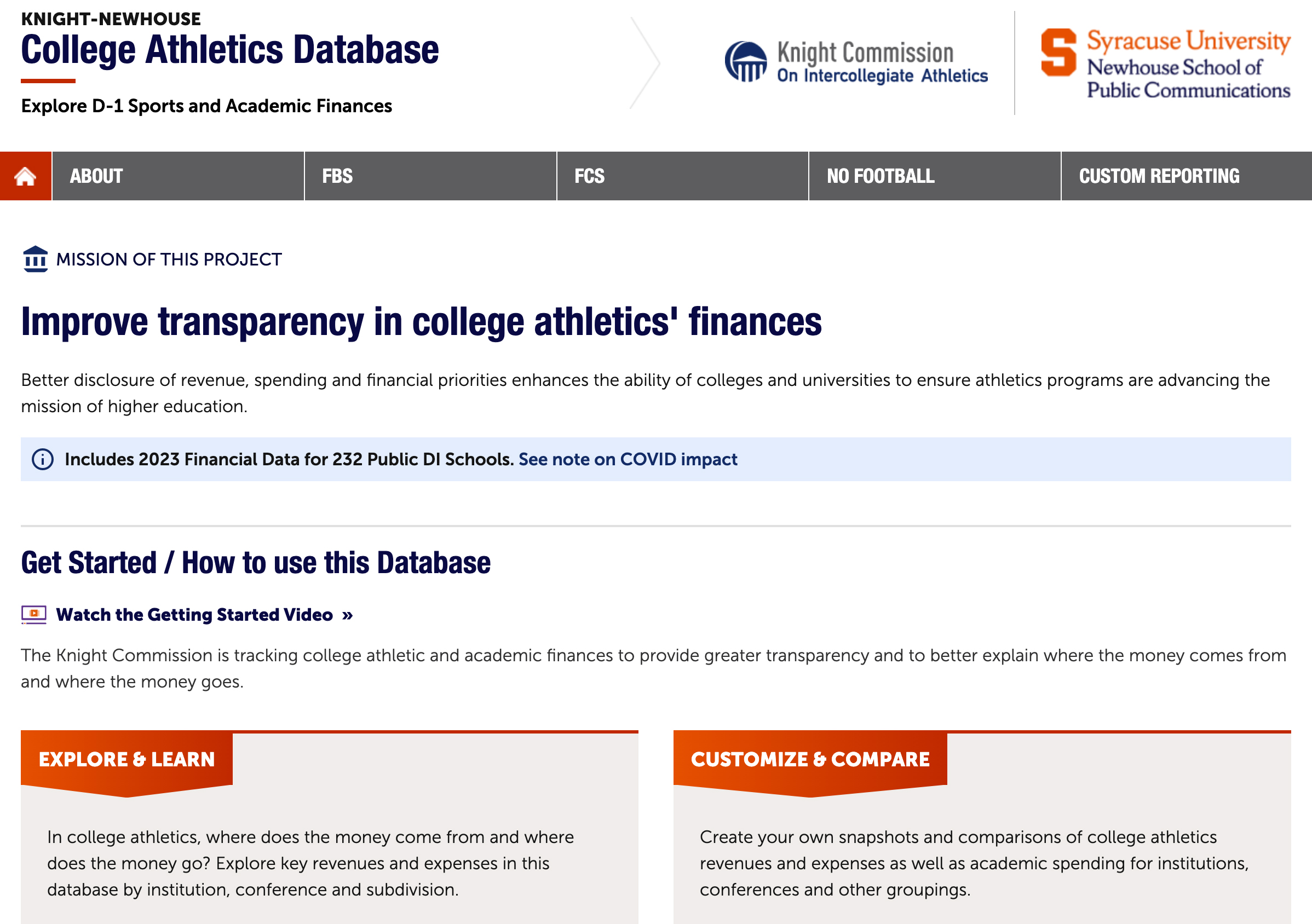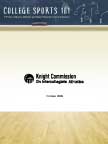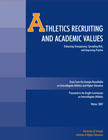Commission Research and White Papers
Reimagining College Sport in an Era of Transformation, December 2024
A narrative review of scholarship & examples of sport-centric curricula within higher education prepared for the Knight Commission on Intercollegiate Athletics by: Erianne A. Weight, PhD, MBA, and Molly Harry, PhD. The Knight Commission has discussed this central topic in prior years and its interest is elevated in advancing consideration as the FCS & IAAA Athletics Directors Associations propose ways to make athletics participation more integrated in the academic mission.
Study: Literature Review of Division I Athletics Reform, October 2020
The Knight Commission on Intercollegiate Athletics commissioned this work to compile and assess relevant proposals about reform of Division I athletics, over the last decade, and provide a summary of those proposals which can inform the Knight Commission’s work in assessing the NCAA and Division I organizational, regulatory and governance structure and in developing possible new alternative models.
NCAA Division I Governance and Organizational/Competitive Structure Survey, October 2020
The vast majority of NCAA Division I campus and sports leaders believe that college sports reform should be focused on “big solutions,” a new survey from the Knight Commission on Intercollegiate Athletics shows. The groundbreaking survey reveals far-ranging dissatisfaction with current Division I governance. The survey, conducted June 18 – July 14, 2020 for the Knight Commission by Shugoll Research of Bethesda, Maryland, found that nearly 80 percent of respondents agreed with the statement that “Division I reform should look for ‘big solutions’ rather than incremental changes.” View survey highlights, the complete report, and the appendices:
An Assessment of Football Bowl Subdivision (FBS) Football Factors on National Collegiate Athletic Association (“NCAA”), Division I 2018 Revenue Distribution, September 2020
A new Knight Commission-sponsored study by CliftonLarsonAllen (CLA), a national professional services firm, released on September 30, 2020 analyzes the NCAA’s distribution of revenues from the NCAA Division I Men’s Basketball Tournament, focusing on schools that field Football Bowl Subdivision (FBS) football teams. Based on CLA’s report, along with the Knight Commission’s longtime analysis of related issues, the Commission concludes that the current NCAA distribution methodology disproportionately rewards FBS schools.
Assessment of Intercollegiate Athletics Financial Reporting, March 2020
This report was completed by Collegiate Financial Partners, LLC with support from the Knight Commission on Intercollegiate Athletics to conduct nonpartisan analysis, study and research and prepare an educational document on the subject of the reporting obligations applicable to college sports financing.
The NCAA and “Non-Game Related” Student-Athlete Name, Image and Likeness Restrictions
Professor Gabe Feldman, Tulane Law School and Director, Tulane Sports Law Program presented a white paper at the May 2016 meeting of the Knight Commission on Intercollegiate Athletics. In it, he proposed a model that would eliminate some of the current restrictions on college athletes using their celebrity for financial gain by signing autographs or engaging in commercial endorsements using an athlete’s non-game related name, image, or likeness (NIL).
Knight Commission Studies Interest in Alternative Division I Competition Models
A Knight Commission on Intercollegiate Athletics study reveals interest among university presidents, athletics administrators, faculty and head coaches in exploring alternative models for Division I competition and administration of different sports that may reduce missed class time and travel costs. The study was conducted to assess interest in whether different structures in various sports might offset the challenging effects of some conferences’ newly enlarged geographic footprints.
Knight Commission memorandum to NCAA President Mark Emmert and NCAA Board of Directors on NCAA governance and related issues, August 2013
The Commission officially launched its governance review in 2012 following a decision reached at its October 24, 2011 meeting that such an examination was needed despite recent progress toward achieving important academic reforms. The Commission believed then—as it does now—that significant issues continue to challenge the operation and integrity of Division I intercollegiate athletics. Many of these issues are outside of the NCAA’s control and/or beyond the scope of the NCAA’s reform agenda launched in late 2011. The objective of the Commission’s review was to assess whether different approaches in the Division I model and governance might improve accountability and better serve both institutions and college athletes. The fragmented oversight for the highest level of college football, and for the billions of dollars in revenue it produces, was a key element in this examination.
The review focused on in-depth interviews with nearly 50 higher education and college sports leaders. The interviews were conducted in spring 2013 by Art & Science Group, the education research firm that conducted the Commission’s 2009 survey of presidents at Football Bowl Subdivision (FBS) institutions. Several current and past members of the NCAA Executive Committee and Division I Board of Directors participated in this new study.
 Knight-Newhouse College Athletics Database The Knight-Newhouse College Athletics Database (knightnewhousedata.org), known before 2021 as the College Athletics Financial Information (CAFI) Database, is an authoritative source for understanding college sports finances. The interactive, user-friendly tool provides unprecedented access to athletics revenues, expenses, and debt at more than 230 public NCAA Division I colleges and universities dating back to 2005. Academic spending data are also available. With the goal of improving accountability, this database is an essential tool to provide greater transparency for college sports finances.
Knight-Newhouse College Athletics Database The Knight-Newhouse College Athletics Database (knightnewhousedata.org), known before 2021 as the College Athletics Financial Information (CAFI) Database, is an authoritative source for understanding college sports finances. The interactive, user-friendly tool provides unprecedented access to athletics revenues, expenses, and debt at more than 230 public NCAA Division I colleges and universities dating back to 2005. Academic spending data are also available. With the goal of improving accountability, this database is an essential tool to provide greater transparency for college sports finances.
Changing the game, Kirwan, W., and Turner, G. (2010)
In the 2010 September/October issue of Trusteeship, read about how rising athletic expenses are becoming a destabilizing force for many institutions. William E. “Brit” Kirwan and R. Gerald Turner show you how the game is changing.
 College Sports 101: A Primer on Money, Athletics, and Higher Education in the 21st Century (produced in 2009)
College Sports 101: A Primer on Money, Athletics, and Higher Education in the 21st Century (produced in 2009)
This 2009 report offered an overview of the business and economic landscape of intercollegiate athletics, with a particular focus on the Football Bowl Subdivision, the top competitive tier of the National Collegiate Athletic Association. It is designed to help policymakers, academic leaders, and other interested parties understand both the economic forces that shape decision making in athletics and the financial consequences of those decisions for higher education as a whole. It also is intended to provide background and context as the Knight Commission considers solutions to the problems.
Presidential Survey on the Cost and Financing of Intercollegiate Athletics, July 2009
The survey reports the views of presidents for the Football Bowl Subdivision (formerly Division I-A) universities on the costs and financing of intercollegiate athletics. The findings are based on 95 quantitative telephone interviews and 22 qualitative follow-up telephone interviews with presidents. The quantitative component achieved an 80 percent completion rate. The study was conducted by Art & Science Group of Baltimore, MD, from March to July 2009. For Report Appendices, link here.
Executive Summary of Faculty Perceptions of Intercollegiate Athletics Survey, October 2007
In a national survey of more than 2,000 faculty members at universities with the country’s most visible athletic programs, a striking number of professors say they don’t know about and are disconnected from issues facing college sports. More than a third say they don’t know about many athletics program policies and practices, including the financial underpinnings of their campuses’ athletics programs. Furthermore, more than a third have no opinion about concerns raised by national faculty athletics reform groups. …
Faculty Perceptions of Intercollegiate Athletics
The main goal of the Faculty Perceptions of Intercollegiate Athletics Survey is to examine professors’ beliefs about and satisfaction with intercollegiate athletics. The investigation also identifies faculty members’ primary concerns about intercollegiate athletics and gathers preliminary data on whether they would join campus-based initiatives aimed at ameliorating these concerns. Further, the survey assesses whether professors think such activities would lead to meaningful change on their campus…
Public Opinion Poll, Jan. 2006
The Census-balanced and representative telephone poll of 502 adults among adults 18 years of age and older was conducted in December 2005 for the commission by Widmeyer Research and Polling of Washington, D.C. The margin of error for the poll is +/- 4.4%. Poll findings suggest the following:
Americans believe college sports are like professional sports…
Public Opinion Poll, Dec. 2005
A recent Census-balanced and representative telephone poll among 502 American adults completed in late December 2005 for the Knight Commission on Intercollegiate Athletics by Widmeyer Research and Polling of Washington, DC found that: Americans say the NCAA should “stay the course but remain diligent.” …
 Athletics Recruiting and Academic Values: Enhancing Transparency, Spreading Risk, and Improving Practice
Athletics Recruiting and Academic Values: Enhancing Transparency, Spreading Risk, and Improving Practice
“Universities and even some colleges can seem to exist in different worlds from their athletics programs, particularly at institutions where some sports attract broad outside interest. Nevertheless, contexts and interests appear to diverge considerably more than they actually do.” A paper from a Roundtable on Intercollegiate Athletics and Higher Education, University of Georgia Institute of Higher Education, Fall 2006.
Challenging the Myth: A Review of the Links Among College Athletic Success, Student Quality and Donations
An integrative review of the economic literature on intercollegiate athletics by Cornell University economist Robert Frank. May 2004.
Executive Summary of Division I-A Postseason History and Analysis
The summary of discusses the proposed changes to the Division I-A postseason football system being discussed in Spring 2004 and designed to remedy some of its current problems. It emphasizes that the lack of a governing authority able to consider and address all the key issues – business, educational, and political – is a material weakness. The report does not offer specific solutions, but focuses on facts and data for stakeholders’ reference when considering what is “arguably the most visible face of higher education to the U.S. public at large.”
Division I-A Postseason History and Analysis
John Sandbrook’s 2004 report, “Division I-A Postseason Football History and Status,” prepared at the request of the Knight Foundation Commission on Intercollegiate Athletics, offers a comprehensive examination of Division I-A postseason football, from the historical roots of bowl games as civic events designed to promote tourism to today’s environment where games are viewed primarily as television properties. The report provides supporting data for critical aspects of the bowl system and its participating institutions, including scheduling information compared to the academic calendar, television and sponsorship arrangements, financial results, and the distribution of participation opportunities by each Division I-A conference and institution. The report examines the overwhelming role economic factors continue to play in every facet of the bowl system, including the critical issue of its governance and the negotiation and administration of its largest revenue factor – television rights – as separate properties rather than as a consolidated package or sets of packages.
